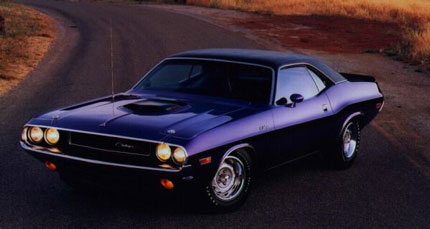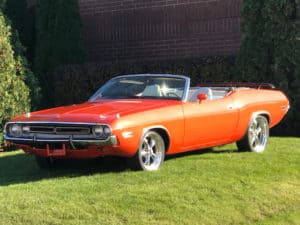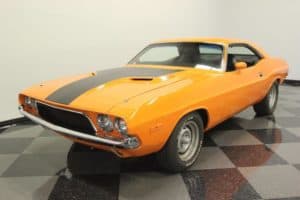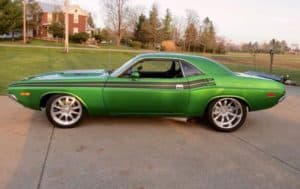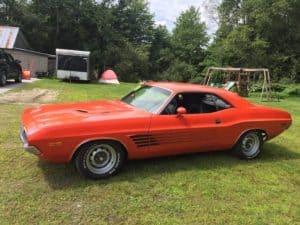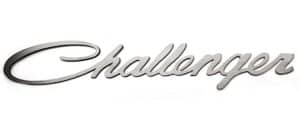
The Challenger is described in a book about 1960s American cars as Dodge’s “answer to the Mustang and Camaro.”It was one of two Chrysler E-body cars, the other being the slightly smaller Plymouth Barracuda. “Both the Challenger and Barracuda were available in a staggering number of trim and option levels” and were intended “to compete against cars like the Chevrolet Camaro and Ford Mustang, and to do it while offering virtually every engine in Chrysler’s inventory.” However they were “a rather late response to the ponycar wave the Ford Mustang had started.” The author of a book about “Hemi”-powered muscle cars says that the Challenger was conceived in the late 1960s as Dodge’s equivalent of the Plymouth Barracuda, and that the Barracuda was designed to compete against the Mustang and Camaro. He adds that Chrysler intended the new Dodge as “the most potent ponycar ever,” and positioned it “to compete against the Mercury Cougar and Pontiac Firebird.” Similarly, the author of a book about the Chrysler pony-cars notes that “the Barracuda was intended to compete in the marketplace with the Mustang and Camaro/Firebird, while the Dodge was to be positioned against the Cougar” and other more luxury-type musclecars.
The Challenger’s longer wheelbase, larger dimensions and more luxurious interior were prompted by the launch of the 1967 Mercury Cougar, likewise a bigger, more luxurious and more expensive pony car aimed at affluent young American buyers. The wheelbase, at 110 inches, was two inches longer than the Barracuda, and the Dodge differed substantially from the Plymouth in its outer sheetmetal, much as the Cougar differed from the shorter-wheelbase Ford Mustang.
Exterior design was done by Carl Cameron, who also did the exterior for the 1966 Dodge Charger. Cameron based the 1970 Challenger grille off an older sketch of his 1966 Charger prototype that was to have a turbine engine. The Charger never got the turbine, but the Challenger got that car’s grille. Although the Challenger was well-received by the public (with 76,935 produced for the 1970 model year), it was criticized by the press, and the pony car segment was already declining by the time the Challenger arrived. Sales fell dramatically after 1970, and Challenger production ceased midway through the 1974 model year. About 165,500 Challengers were sold over this model’s lifespan.
Four models were offered: Challenger Six, Challenger V8, T/A Challenger, and Challenger R/T. Challengers could either be hardtops, coupes, or convertibles (through 1971 only). The standard engine on the base model was the 225 cu in six-cylinder. Standard engine on the V8 was the 230 bhp 318 cu in V8 with a 2-barrel carburetor. Optional engines were the 340 cu in and 383 cu in V8s, all with a standard 3-speed manual transmission, except for the 290 bhp 383 CID engine, which was available only with the TorqueFlite automatic transmission. A 4-speed manual was optional on all engines except the 225 CID I6 and the 383 CID V8.
The performance model was the R/T (Road/Track), with a 383 CID Magnum V8, rated at 335 bhp. Standard transmission was a 3-speed manual. Optional R/T engines were the 375 bhp 440 CID Magnum, the 390 bhp 440 cu in Six-Pack and the 425 bhp 426 cu in Hemi. The R/T was available in all three body styles; both standard and R/T hardtops could be ordered as the more luxurious SE specification, which included leather seats, a vinyl roof, a smaller ‘formal’ rear window, and an overhead interior console that contained three warning lights (door ajar, low fuel, and seatbelts). The Challenger R/T came with a Rallye instrument cluster which included a 150 mph speedometer, an 8,000 rpm tachometer, and an oil pressure gauge. The convertible Challenger was available with any engine, as well as in the R/T and SE trim levels. In 1973, Dodge dropped the R/T badging and now called it the “Rallye”, although it was never badged as such. The shaker hood scoop was not an option for 1972.
On December 3, 2007, Chrysler started taking deposits for the third-generation Dodge Challenger, which debuted on February 6, 2008 simultaneously at the Chicago Auto Show and Philadelphia International Auto Show. Listing at US$40,095, the new version is a 2-door coupe which shares common design elements with the first generation Challenger, despite being significantly longer and taller. The chassis is a modified (shortened wheelbase) version of the LX platform that underpins the 2006-Current Dodge Charger, 2005-2008 Dodge Magnum, and the 2005-Current Chrysler 300. It is equipped with the SRT8 6.1 L (370 cu in) Hemi and a 5-speed AutoStick automatic transmission, and outperforms the legendary 1970 Hemi Challenger. The entire 2008 run of 6,400 cars were pre-sold (many of which for above MSRP), and production commenced on May 8, 2008. Chrysler of Mexico is offering only 100 of this car for that country with a 6.1 liter engine and 425 brake horsepower; the version is SRT/8. Chrysler has auctioned off two 2008 SRT8 for charity. 2008 Challenger SRT8 #1 has been auctioned off for $400,000.00 to benefit the notMYkid non-profit org, and a ‘B5’ Blue Challenger SRT8 #43 with a winning bid of $228,143.43 with the proceeds going to Victory Junction Gang Camp.
At the 2008 New York Auto Show, Chrysler debuted the full Dodge Challenger line for 2009, with three different trims (SE, R/T, and SRT8) to choose from:
SE
2009 Dodge Challenger SEThe base model Challenger is powered by a 3.5 L (214 cu in) SOHC V6 producing 250 brake horsepower and 250 lb·ft torque which is coupled to a 4-speed automatic transmission. Several different exterior colors, and either cloth or leather interiors are available. Standard features include air conditioning; power windows, locks, and mirrors; cruise control; and 17-inch aluminum wheels. Leather upholstery, heated front seats, sunroof, 18-inch aluminum wheels, and a premium audio system are available as options, as are ABS, and stability and traction control. The Canadian market also sports the SXT trim, similar to the SE, however is even more generous in terms of standard features. Some of these features being ESP, and alarm system, and 18 inch wheels.
R/T
2009 Dodge Challenger R/T The mid-level Challenger is powered by a 5.7 L (345 cu in) HEMI V8 producing and coupled to either a 5-speed auto or 6-speed manual transmission. With the 6-speed manual, the Multi-Displacement System option is deleted, but the engine produces 375 brake horsepower and 404 lb·ft torque, whereas the 5.7 L (345 cu in) V8 with automatic transmission makes only 370 brake horsepower and 398 lb·ft torque.
R/T Classic
The brochure of the 2009 Challenger shows a “classic” version of the Dodge Challenger R/T, with the 5.7 L (345 cu in) HEMI, and retro aspects such as script “Challenger” badges on the front panels and black “R/T” stripes. It will be produced in B5 Blue only, and will be late availability.
SRT8
2009 Dodge Challenger SRT8 The ’09 SRT8 is virtually identical to its ’08 counterpart, with the main difference being the choice of either a 5-speed automatic or a 6-speed manual transmission. Standard features include big Brembo brakes, a special suspension, bi-xenon headlamps, heated leather sport seats, keyless go, Sirius satellite radio, and 20-inch forged aluminum wheels in addition to most amenities offered on the lower R/T and SE grades like air conditioning and cruise control. In addition, the 2009 will have a true “limited slip” differential.
Convertible
A convertible version of the Challenger is rumored to be headed for production for 2010.
Drag Race Package
It is a race model designed for NHRA competition, based on Dodge Challenger SRT-8. The car is 1000lbs lighter than the street vehicle by eliminating major production components and systems. To accentuate the weight savings, they also feature added composite, polycarbonate and lightweight components designed for drag racing that will be part of the new Package Car program. The engine was repositioned to improve driveline angle and weight distribution. The 116-inch wheelbase was shortened by ½ inch. They also feature a front cradle with bolt-in crossmember and solid engine mounts.
At least 100 Challenger Drag Race Package Cars were built to meet NHRA requirements. Engine options include 6.1L HEMI, 5.7-L HEMI, 5.9L Magnum Wedge. Manual or automatic transmissions are available.
1970 Challenger |
||||||||||||||||||||||||||||||||||||||||||||||||||
|
|
||||||||||||||||||||||||||||||||||||||||||||||||||
|
||||||||||||||||||||||||||||||||||||||||||||||||||
1971 Challenger |
||||||||||||||||||||||||||||||||||||||||||||||||||
|
|
||||||||||||||||||||||||||||||||||||||||||||||||||
|
||||||||||||||||||||||||||||||||||||||||||||||||||
1972 Challenger |
||||||||||||||||||||||||||||||||||||||||||||||||||
|
|
||||||||||||||||||||||||||||||||||||||||||||||||||
|
||||||||||||||||||||||||||||||||||||||||||||||||||
1973 Challenger |
||||||||||||||||||||||||||||||||||||||||||||||||||
|
|
||||||||||||||||||||||||||||||||||||||||||||||||||
|
||||||||||||||||||||||||||||||||||||||||||||||||||
1974 Challenger |
||||||||||||||||||||||||||||||||||||||||||||||||||
|
|
||||||||||||||||||||||||||||||||||||||||||||||||||
|
||||||||||||||||||||||||||||||||||||||||||||||||||
2008 Challenger |
||||||||||||||||||||||||||||||||||||||||||||||||||
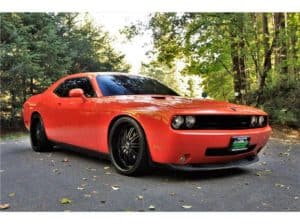 |
||||||||||||||||||||||||||||||||||||||||||||||||||
|
||||||||||||||||||||||||||||||||||||||||||||||||||
2009 Challenger |
||||||||||||||||||||||||||||||||||||||||||||||||||
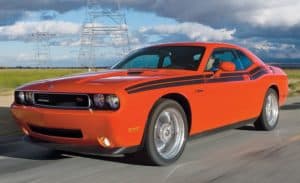 |
||||||||||||||||||||||||||||||||||||||||||||||||||
|
||||||||||||||||||||||||||||||||||||||||||||||||||

